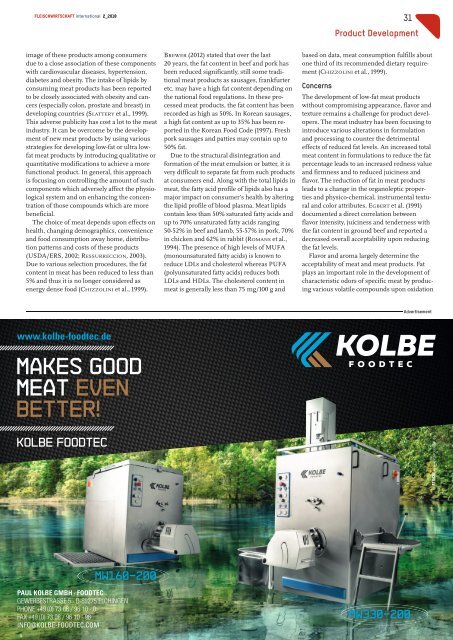FLEISCHWIRTSCHAFT international 2/2018
Create successful ePaper yourself
Turn your PDF publications into a flip-book with our unique Google optimized e-Paper software.
Fleischwirtschaft <strong>international</strong> 2_<strong>2018</strong><br />
31<br />
Product Development<br />
image of these products among consumers<br />
due to aclose association of these components<br />
with cardiovascular diseases, hypertension,<br />
diabetes and obesity.The intake of lipids by<br />
consuming meat products has been reported<br />
to be closely associated with obesity and cancers<br />
(especially colon, prostate and breast) in<br />
developing countries (SLATTERY et al., 1999).<br />
This adverse publicity has cost alot to the meat<br />
industry.Itcan be overcome by the development<br />
of new meat products by using various<br />
strategies for developing lowfat or ultra lowfat<br />
meat products by introducing qualitative or<br />
quantitative modifications to achieve amore<br />
functional product. In general, this approach<br />
is focusing on controlling the amount of such<br />
components which adversely affect the physiological<br />
system and on enhancing the concentration<br />
of those compounds which are more<br />
beneficial.<br />
The choice of meat depends upon effects on<br />
health, changing demographics, convenience<br />
and food consumption away home, distribution<br />
patterns and costs of these products<br />
(USDA/ERS, 2002; RESSURRECCION,2003).<br />
Due to various selection procedures, the fat<br />
content in meat has been reduced to less than<br />
5% and thus it is no longer considered as<br />
energy dense food (CHIZZOLINI et al., 1999).<br />
BREWER (2012)stated that over the last<br />
20 years, the fat content in beef and pork has<br />
been reduced significantly,still some traditional<br />
meat products as sausages, frankfurter<br />
etc. may have ahigh fat content depending on<br />
the national food regulations. In these processed<br />
meat products, the fat content has been<br />
recorded as high as 50%. In Korean sausages,<br />
ahigh fat content as up to 35% has been reported<br />
in the Korean Food Code (1997). Fresh<br />
pork sausages and patties may contain up to<br />
50% fat.<br />
Due to the structural disintegration and<br />
formation of the meat emulsion or batter,itis<br />
very difficult to separate fat from such products<br />
at consumers end. Along with the total lipids in<br />
meat, the fatty acid profile of lipids also has a<br />
major impact on consumer’s health by altering<br />
the lipid profile of blood plasma. Meat lipids<br />
contain less than 50% saturated fatty acids and<br />
up to 70% unsaturated fatty acids ranging<br />
5052% in beef and lamb, 5557% in pork, 70%<br />
in chicken and 62% in rabbit (ROMANS et al.,<br />
1994). The presence of high levels of MUFA<br />
(monounsaturated fatty acids) is known to<br />
reduce LDLs and cholesterol whereas PUFA<br />
(polyunsaturated fatty acids) reduces both<br />
LDLs and HDLs. The cholesterol content in<br />
meat is generally less than 75 mg/100gand<br />
based on data, meat consumption fulfills about<br />
one third of its recommended dietary requirement<br />
(CHIZZOLINI et al., 1999).<br />
Concerns<br />
The development of lowfat meat products<br />
without compromising appearance, flavor and<br />
texture remains achallenge for product developers.<br />
The meat industry has been focusing to<br />
introduce various alterations in formulation<br />
and processing to counter the detrimental<br />
effects of reduced fat levels. An increased total<br />
meat content in formulations to reduce the fat<br />
percentage leads to an increased redness value<br />
and firmness and to reduced juiciness and<br />
flavor.The reduction of fat in meat products<br />
leads to achange in the organoleptic properties<br />
and physicochemical, instrumental textural<br />
and color attributes. EGBERT et al. (1991)<br />
documented adirect correlation between<br />
flavor intensity,juiciness and tenderness with<br />
the fat content in ground beef and reported a<br />
decreased overall acceptability upon reducing<br />
the fat levels.<br />
Flavor and aroma largely determine the<br />
acceptability of meat and meat products. Fat<br />
plays an important role in the development of<br />
characteristic odors of specific meat by producing<br />
various volatile compounds upon oxidation<br />
Advertisement

















